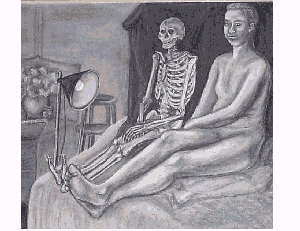
Art
NUDE, NAKED, AND ART
According to convention, the nude model is a silent and dehumanized object, a sterile and asexual concoction of geometric shapes. Even if this convention were accurately descriptive of nude art modeling, is it normatively desirable? Is it really necessary that artists and art students suspend their disbelief in the eroticism-charged performance presentation and only regard, with aesthetic distance, a show of naked body description?
What is this "aesthetic distance," anyway? Aesthetic distance is surely necessary for some; the need for frames around a picture shows that. But might some of the aesthetic distance in the use of nude models simply an excuse for avoidance of the complexities of their humanness, most especially their sexually-charged nakedness and conspicuous sex-organs so plainly paraded to decently attired artists, art students, and not-so-occasional outside onlookers?
Let's not pretend that this kind of aesthetic distance is necessary for art. Raw naked human sexuality has been a legitimate part of art since the dying days of the Last Ice Age. It is visible in cave paintings like those at Lascaux and Altamira and their contemporary plump naked Venus figurines. In the earliest art we can find, unambiguous sexual male humans with stiff erect penises cavort across cave walls along with big healthy beasts that they are presumably hunting. The Venus Figurines of that era show unambiguous sexual female humans with full breasts and vaginal areas. And this sensuality plainly continues through art history, from ancient Egyptian, ancient Peruvian, ancient Greco- Roman, Renaissance European, and modern pre-photographic drawn, painted, and sculpted nudes.
The sexual male and female nudes in Hieronymus Bosch's triptychs literally tell stories about normal human sexuality that is sometimes termed "bizarre," but only to differentiate it from more customary sexual behaviors. One might wonder what Bosch would see in the plethora of explicit Internet offerings of nude male and female humans engaging in "bizarre" sex that less artfully illustrate his kind of art. The sexual, almost to the point of pornographic, voluptuous nebulous inviting nude females of Renoir taunt us about the underlying decency and fun of human sexuality and sexual arousal.
This same raw naked human sexuality is what is put on display in the contemporary use of nude art models. At precisely the moment at which the practice of art-making claims to be at the opposite pole of sensuality - that is, absorbed in the practical challenges of representing geometric forms - it is in fact suffused with the erotic energy that has been at the center of art for millennia.
What are we without libidos? We are robots. Already our daily and nightly lives are dominated by robot-like digital brains lacking minds or souls, let alone libidos, from whence creative human thought appears to spring. What brave new world might we be leading ourselves into? In such a context, rather than running from the eroticism of the art studio's nudity, blatantly ogling naked human bodies for their innate sexuality and sexual arousal might be a better road to take - perhaps even a necessary road to counter the one we are now rushing so headlong down.

|
|
Tom Slattery is the author of several novels, including "The Goddess of
Love and the Angel of Death" (available at amazon.com, borders, etc.), the
research for which was the basis of this article.
Carol Schmidt describes herself as a "writer who has started to dabble in
art," and has three published novels available at major retailers.
What draws protesters to shout about banal holocaust art?
April, 2002



film politics music jay's head poetry art masthead letters archive